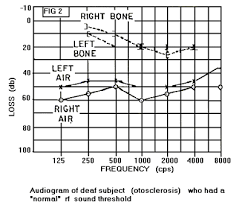
An audiogram is a graph display of one's hearing threshold (i.e. the lowest volume one can here at various pitches or frequencies). Volume is measured in decibles (dB) and pitch is measured in hertz (Hz). X is the symbol for left ear measurements and O is the symbol for right
ear measurements.
ear measurements.
When given an air or bone conduction test, your child is presented sounds at various frequencies (beginning at 125 Hz through 8000 Hz) beginning at 0dB and increasing volume increments until an affirmative response is made indicating hearing threshold for that particular frquency.
Typical conversation is measured around 45dB. However, if your child's audiogram measures affirmative response at 0 dB, this means that your child is accurately responding to that particular frequency at the softest possible level at least 50% of the time.
Severity of Hearing Loss:
If a child presents with affirmative responses 20 dB or below for all frequencies (pitches), their hearing acuity is judged to be typical as compared to same-aged peers. Hearing thresholds between 20-40 dB is considered Mild hearing loss; 40-55 dB is judged to be a Moderate hearing loss; 55-70 dB is labeled as Moderately-Severe hearing loss; 70-90 dB is considered Severe hearing loss, and any hearing thresholds found to be greater than 90dB is judged to be a profound hearing loss.
If a child presents with affirmative responses 20 dB or below for all frequencies (pitches), their hearing acuity is judged to be typical as compared to same-aged peers. Hearing thresholds between 20-40 dB is considered Mild hearing loss; 40-55 dB is judged to be a Moderate hearing loss; 55-70 dB is labeled as Moderately-Severe hearing loss; 70-90 dB is considered Severe hearing loss, and any hearing thresholds found to be greater than 90dB is judged to be a profound hearing loss.
Three Types of Hearing Loss:
There are three types of hearing loss: conductive, sensorineural and mixed (a combination of conductive and sensorineural). Conductive hearing loss occurs in the outer and middle ear and often times can be remediated via simple measures. Sensorineural hearing loss occurs in the inner ear and may or may not be able to be resloved via surgery. One can have a mixed hearing loss which is a combination of both conductive and sensorineural hearing loss.
There are three types of hearing loss: conductive, sensorineural and mixed (a combination of conductive and sensorineural). Conductive hearing loss occurs in the outer and middle ear and often times can be remediated via simple measures. Sensorineural hearing loss occurs in the inner ear and may or may not be able to be resloved via surgery. One can have a mixed hearing loss which is a combination of both conductive and sensorineural hearing loss.
Readingy a Tympannogram:
A tympannogram is used to measure the fluidity of movement of the typmannic membrane (i.e. ear drum) and middle ear bones.
A typical response indicates adequate movement of the typmanic membrane (ear drum) and ossiclation of middle ear bones.
A tympannogram is used to measure the fluidity of movement of the typmannic membrane (i.e. ear drum) and middle ear bones.
A typical response indicates adequate movement of the typmanic membrane (ear drum) and ossiclation of middle ear bones.
A hyperflaccid response inidicates more typmannic membrane movement than necessary affecting hearing acuity.
A stiff ear response indicates less movement than needed for typmanic membrane and middle ear bones. Most common causes of this would be ear infections, however there are other less familiar causes as well.
This is a very simplistic description of tympannogram responses. As I am not an audiologist, I will leave the more indepth discussions up to the professionals. Just understand that any atypical response can affect hearing. Causes and possible treatments should be discussed with a licensed audiologist!
If you are concerned with your child's hearing or question weather he/she is hearing accurately, don't hesitate to contact a nearby licensed audiologist for a consultation!
Happy Talking and Hearing!!!
No comments:
Post a Comment